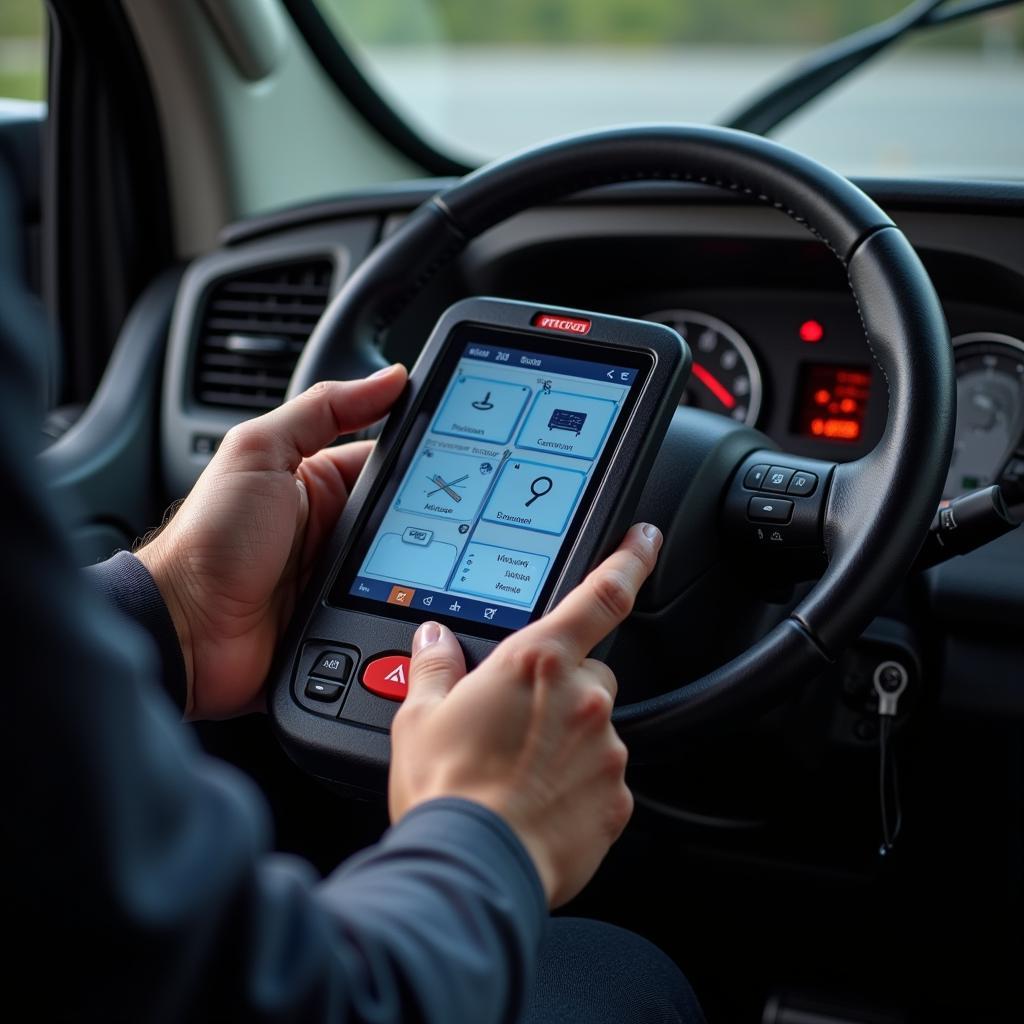If you’re experiencing braking issues with your 2010 Ford, particularly a spongy brake pedal or difficulty stopping, air might be trapped in your brake lines. This requires bleeding the brake system, a process made easier and more efficient with a 2010 Ford Brake Bleed Scan Tool. This comprehensive guide will walk you through the importance of a scan tool, how to choose the right one, and a step-by-step guide on bleeding your brakes.
Why Use a 2010 Ford Brake Bleed Scan Tool?
While traditional brake bleeding methods exist, employing a scan tool offers significant advantages for your 2010 Ford:
- Activate the ABS Module: Modern vehicles like your Ford often require electronic activation of the Anti-lock Braking System (ABS) module during bleeding. Scan tools can communicate with this module, ensuring a complete and effective bleed.
- Precise Control: A scan tool allows for precise control over the bleeding process, minimizing the risk of introducing air back into the system. This precision leads to a firmer brake pedal and improved stopping power.
- Time Savings: Utilizing a scan tool can dramatically reduce the time required to bleed your brakes, particularly compared to manual methods.
- Diagnostics: Beyond bleeding, some scan tools provide diagnostic capabilities, allowing you to identify other potential issues with your Ford’s brake system, such as faulty sensors or leaks.
Choosing the Right Brake Bleed Scan Tool
Selecting the appropriate scan tool is crucial. Consider these factors:
- Compatibility: Ensure the scan tool explicitly states compatibility with your 2010 Ford model.
- Functionality: Determine your needs. Do you require basic bleeding functionality, or are you interested in additional diagnostic features?
- Ease of Use: Opt for a user-friendly scan tool with clear instructions and an intuitive interface.
- Budget: Scan tools range in price. Set a budget beforehand and explore options within your range.
Step-by-Step Guide to Bleeding Your Brakes with a Scan Tool
Before starting, gather the necessary equipment: a compatible scan tool, brake fluid (DOT 3 or DOT 4 as recommended by Ford), a wrench that fits your bleeder valves, a clear plastic hose, and a container to collect the old brake fluid.
- Safety First: Park your vehicle on a level surface, engage the parking brake, and disconnect the negative battery cable.
- Connect the Scan Tool: Locate your Ford’s OBD-II port (usually under the dashboard on the driver’s side) and connect the scan tool.
- Enter Vehicle Information: Power on the scan tool and input your Ford’s specific year, make, and model.
- Access ABS Bleeding Function: Navigate the scan tool’s menu to locate the ABS bleeding function. The exact steps may vary depending on the tool.
- Prepare the Bleeding Sequence: Consult your Ford’s service manual for the recommended bleeding sequence, typically starting with the wheel furthest from the master cylinder.
- Bleed the Brakes:
- Ask an assistant to press and hold the brake pedal.
- Open the bleeder valve on the designated wheel using the wrench.
- Close the valve once the brake fluid flowing through the hose appears clean and free of bubbles.
- Repeat this process for each wheel according to the bleeding sequence.
- Conclude Bleeding Process: Follow the scan tool’s prompts to finalize the ABS bleeding procedure.
- Top Off Brake Fluid: Check the brake fluid level in the master cylinder and add more as needed.
- Test Your Brakes: Reconnect the negative battery cable. Before driving, pump the brakes several times to restore pressure and ensure a firm pedal feel.
Frequently Asked Questions
1. Can I bleed my 2010 Ford brakes without a scan tool?
While possible, it’s not recommended. Modern Fords often require electronic activation of the ABS module for a complete bleed.
2. How often should I bleed my brakes?
Ford recommends brake fluid flushes every 30,000 miles or 2 years, whichever comes first.
3. What happens if I don’t bleed my brakes?
Air in the brake lines can lead to a spongy brake pedal, reduced braking performance, and potentially dangerous driving conditions.
4. Can a scan tool diagnose other brake problems?
Yes, many scan tools offer diagnostic capabilities beyond bleeding, such as identifying faulty sensors or leaks.
5. Where can I purchase a reliable brake bleed scan tool?
For high-quality scan tools compatible with your 2010 Ford, we recommend contacting ScanToolUS at +1 (641) 206-8880 or visiting our office at 1615 S Laramie Ave, Cicero, IL 60804, USA.
Conclusion
Using a 2010 Ford brake bleed scan tool ensures a thorough and efficient brake bleeding process. By following the steps outlined in this guide, you can improve your vehicle’s braking performance and ensure your safety on the road. If you have any doubts or require further assistance, don’t hesitate to contact a qualified mechanic or reach out to us at ScanToolUS. Your safety is our priority.

